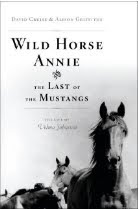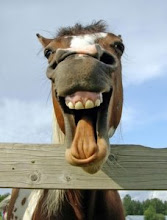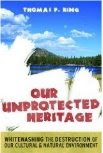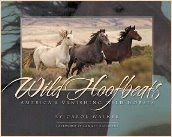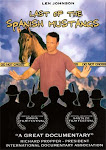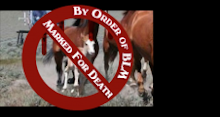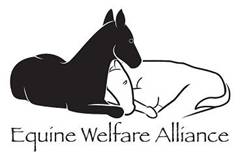 The old gray horse sidled up to the pasture fence with little dancing steps. The place seemed familiar, yet somehow strange. The grass was greener than any grass he'd ever seen, and when he looked closely at the white paddock gate it had a kind of pearly sheen. and there was another funny thing. A big, black cloud hovered just inside the gate. The cloud wasn't up in the sky where it properly belonged. It was like a great puff of black smoke rising from the grass.
The old gray horse sidled up to the pasture fence with little dancing steps. The place seemed familiar, yet somehow strange. The grass was greener than any grass he'd ever seen, and when he looked closely at the white paddock gate it had a kind of pearly sheen. and there was another funny thing. A big, black cloud hovered just inside the gate. The cloud wasn't up in the sky where it properly belonged. It was like a great puff of black smoke rising from the grass. Suddenly the cloud dissolved and revealed a horse. He was a small chestnut with a blunt head and one white stocking and brownish hairs in his tail and mane. The gray horse thought he had a kind of old timely look to him.
"Hello, old gray horse," the chestnut from the black cloud said.
"Hey, that's a real good trick!" the gray horse exclaimed. "Where'd you learn it?"
The chestnut disappeared into the cloud again, but emerged immediately. "Learned it the day I was born," he replied, with a whinny that sounded like a chuckle. "You see, I was born on April Fool's Day and there was a total eclipse of the sun. So they named me Eclipse. I was always playing tricks on people too. Used to kick my rooms and try to throw my riders and I bit the auctioneer that sold me."
"My name is..." the old gray horse started to say politely, but the tricky chestnut ducked in and out of his cloud and interrupted rudely.
"Native Dancer," he said. "I ought to know you. I'm your great-great- great-great- great - I always lose count of the 'greats' - but anyway, you're a descendant of mine. almost everybody is, in fact. The Thoroughbreds, that is."
"Are you the gatekeeper?" Native Dancer asked.
"Mostly," Eclipse replied. "I'm on duty whenever one of my descendants is coming up. That's mostly so far as the Thouroughbreds go. Old Matchem has a few left and he takes over when one's due. And poor old Herod, he's posted here occasionally, but there's not many of his male line that aren't here already."
"What is this place" Native Dancer asked. "I guess I'm kind of lost."
"The Green Place," Eclipse replied. "That's what it's called. The Green Place. Most of the horses that get lost, come here. We have to send some back of course."
"Why?" the Dancer asked.
"Because they don't belong here, that's why. Long before I came up there was this fellow Bayard, for instance. He was a devil-horse. Belonged to an old necromancer named Malagigi and he did the devil's work. Helped that villain Aymon of Dordogne to triumph over Charlemagne, they say. and a wizard named Michael Scott had a big black beast who used to stomp his feet and set all the bells of Paris ringing. He even caused the towers of the palace to fall down one day. The Big Guy doesn't want that kind here. But we have Jesse James's horse, and Dick Turpin's too. The Big Guy says they did nothing wrong themselves. They were just faithful to their masters, and The Big Guy thinks that's a virtue."
"Who's the Big Guy?" Native Dancer asked.
"You'll find out!" Eclipse answered airily. He lowered his muzzle and pushed the gate open. "You might as well come in. You understand you're on probation though. The Big Guy makes his decisions about new arrivals every Christmas. Let's see, it's November 16, the way you figure things down there. So you won't have long to wait anyway."
"I'll bet The Big Guy is Man O' War" Native Dancer said as he moved inside and gazed over the emerald green expanses that seemed to stretch into infinity.
Eclipse snorted. "Don't get smart, boy" he said. Then he added maliciously, "You'd lose your bet too. The way a lot of people lost their bets on you at Churchill Downs one day.
"Native Dancer felt hurt, for his ancestor had touched a raw nerve. His lip trembled a bit as he replied defensively, "That Derby was the only race I ever lost."
"I never lost even one race," Eclipse said unsympathetically. "So don't get smart up here. The Big Guy doesn't want any smart-alecks in the Green Place. Remember that.
"Native Dancer was a sensitive sort. He felt as if his eyes were teary and he hoped Eclipse didn't notice. "I won 21 out of 22, and Man O'War only won 20 out of 21" he declared. "And my son Kauai King won the Kentucky Derby."
"My sons won three Derbys at Epsom" Eclipse said. "Young Eclipse took the second running and Saltram won the fourth and Sergeant won the fifth, and I'd have won the bloomin' race myself, only they didn't run it in my time. So quit bragging. Somebody's coming and they might overhear you and tell The Big Guy, and that would be a mark against you."
A bay horse who seemed even more old-timey than Eclipse ambled up. "Is it my time now?" he asked eagerly.
"Not yet, Herod," Eclipse answered in a kindly fashion. "Old Fig's on duty now. One of his is on the way."
"Who's Old Fig?" Native Dancer asked. "I never heard of that one."
"There's a lot of things you never heard of, boy," Eclipse replied. "His real name is Figure, but down there they called him Justin Morgan, after his owner. Here he is now."
A very small, dark bay horse with a round barrel, tiny feet, and furry fetlocks came bustling up to the gate. "OK, OK, I'll take over," he said busily. "Where is that boy? Can't stand tardiness. I've got things to do. A load to pull, a field to plough, a race to run, a trot to trot. No time to waste. Where is that boy?"
In the weeks that followed, The Dancer met hundreds, maybe thousands, of horses. Some of them were famous, and some of them were his ancestors and a few of them were his own sons and daughters.
He met a snorting white stallion named Bucephalus who had been approved for the Green Place by The Big Guy even though he was rumored by some that he was cursed by the deadly sin of pride because he had carried a conqueror named Alexander. He met another gray horse who limped because he had stepped on a rusty nail back home just before he became lost forever. His name was Traveller, and he was a war-horse too, in the days when a man named General Lee had owned him. There were other soldier steeds, two of them descendants of the bustling little stallion they called Old Fig up here. One was Phil Sheridan's black Rienzi and the other horse called both Fancy and Little Sorrel who had been the mount of Stonewall Jackson.
Native Dancer found Man O' War an amiable sort despite his proud aristocratic bearing, and he grew especially fond of a bony old fellow named Exterminator, who patiently answered all but one of his questions. He asked the question of everyone: "Who is The Big Guy?" And the answer was always the same: "Wait til Christmas."
He met Messenger and Hambletonian and Hindoo. He met horses that had dared the dreadful fences of the Grand National. He met a horse who stared blindly into the emerald darkness. His name was Lexington. He met horses who had pulled circus wagons and horses who had pulled brewers' trucks and horses who had drawn man's ploughs over the fields of earth, and he met others who had been the mounts of kings and captains.Always the answer to his question was the same: "Wait til Christmas."
Eclipse fussed over him and kept a watchful eye on his behavior and said he neighed too much and asked too many questions. Eclipse could not stand the thought of The Big Guy banishing one of his descendants from the Green Place.
And Native Dancer did not wish to leave. He doubted he could ever find his way to Maryland again if The Big Guy disapproved of him. And the Green Place was very pleasant in all respects. The grass was lush and he met so many interesting horses. Back home he had sometimes been troubled by nightmares, for a Dark Star haunted his dreams, but now he slept peacefully and rarely remembered the Derby he had lost.
He became nervous though, as the weeks went by and the stars grew brighter.
And finally it was time. On a night when the skies burned with starlight all the horses gathered as near as possible to a little hillock of the vast paddock. There were hundreds, thousands, maybe millions of them, a murmuring and expectant throng that seemed to stretch over the emerald grass beneath the diamonds in the heavens.
Eclipse was very tense. He hovered over Native Dancer, whispering, "Look your best now. Be quiet and humble. The Big Guy will be here any minute."
Suddenly the vast throng was silent as the stars themselves. The Big Guy stood on the hillock in a blinding blaze of starlight, and Native Dancer could barely contain himself. He choked back a whinny of derision and whispered to Eclipse, "Is he The Big Guy? He's so little! And he's not even a horse! What did he ever do?"
Eclipse whispered, "He's a donkey. He carried a woman heavy with child to a small town on another night when the stars were bright."
"It was a long, long time ago."
This was written by the late David Alexander, and was first published in The Thoroughbred Record in December 1967, and won the TRA award for that year's outstanding article on TB racing, the forerunner of the Eclipse Award.

This posting is compiled from gifts of dear friends sent over the holidays.
This story, A Christmas Fable and the photograph of the manger, which was a Christmas card, arrived within the same hour of each other and it seemed totally fitting that these two thoughtful and loving gifts should go together to share with everyone else as well.
This last photo was sent by a friend who wanted us all to remember how it was the donkey who carried Jesus, Mary & Joesph to safety during Herod's Massacre of the Innocents.
Each dear friend shared a little piece of themselves to show their respect and honor for the beloved burros and from the bottom of my heart, I thank you for these wonderful gifts.
Merry Christmas Everyone!






 It was the brutally cruel and inhumane treatment of wild horses through a host of barbaric “solutions” such as mustanging, poisoning water holes, driving them off cliffs, and the bloody road to slaughter that sparked public protest to end this ugly historical chapter of the American West.
It was the brutally cruel and inhumane treatment of wild horses through a host of barbaric “solutions” such as mustanging, poisoning water holes, driving them off cliffs, and the bloody road to slaughter that sparked public protest to end this ugly historical chapter of the American West.


